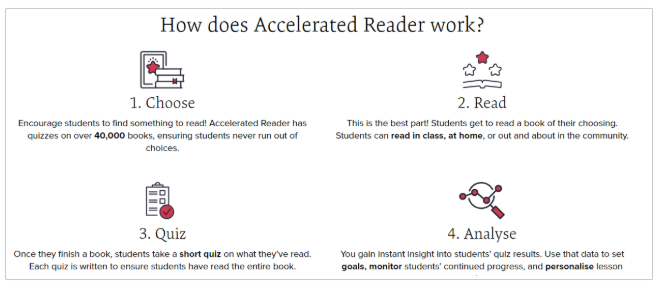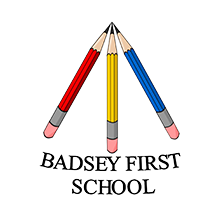English
The overarching aim for English in the National Curriculum is to promote high standards of language and literacy by equipping pupils with a strong command of the spoken and written language and to develop their love of literature through widespread reading for enjoyment.’ National Curriculum, 2014.
At Badsey First School, we don't see reading and writing as separate subjects, but instead we view English skills as a core componant of everything that we do here at school. We want our children to leave us with the skills to communicate effectively with others through spoken and written language and, through exposure to a range of literature, develop culturally, intellectually, socially, emotionally and spiritually.
At Badsey First School our aim is that by the end of their primary education all children are able to read fluently and with confidence. Evidence shows that engagement in reading has the biggest impact on children’s future success. For this to happen, they need to learn to read as fluently as possible and be motivated to continue reading. We want children to have a love for reading that will stay with them for a lifetime.
We follow the Primary National Curriculum for English in England.
/i/video/English_video.mp4
Early Reading - Phonics
What is phonics?
A method of teaching beginners to read and pronounce words by learning to associate letters or letter groups with the sounds they represent. There are 44 main sounds in the English Language. Each sound is represented by a grapheme (the written representation of a sound).
We aim for all children to read well, quickly. ELS
In the GLA we follow Essential Letters and Sounds (ELS). The key principles of ELS are based upon:
- The delivery of whole- class, high-quality first teaching with well-structured daily lesson plans.
- The use of consistent terminology by teachers, children and parents.
- The use of consistent resources that support effective teaching.
- Repetition and reinforcement of learning.
- Regular and manageable assessment to ensure that all children ‘keep up’ rather than ‘catch up’.
- The ‘E’ model
All of our pupils in EYFS and Year 1 have daily ELS lessons. ELS teaching also continues in Year 2 and into Key Stage 2. If required, some pupils receive ELS interventions to support the ELS principle of “Keep up not catch up.” This ensures all our pupils have the best start to early reading.
We regularly host ELS parent sessions which provide you with the opportunity to learn about how we teach phonics to your child/children. These sessions also inform you about reading with your child at home and giving you the opportunity to learn some sounds yourself! If you were unable to attend our most recent session or are new to our school please speak to your child’s class teacher as we are always very happy to provide more information.
For further information on how you can support your child with their phonic learning, please follow the links provided.
You can learn how to say the sounds using the ELS videos below.
Reading
At Badsey First School, part of the GLA, our reading curriculum is designed to develop language skills and foster a lifelong love of reading. Children begin by mastering decoding and blending, progressing through a structured program that helps them become fluent readers. They will tackle increasingly complex texts, strengthening their reading techniques and applying these skills across all subjects.
We believe that enriching experiences help cultivate a passion for reading and spark meaningful discussions. The books we choose will either broaden children’s horizons by introducing them to new ideas and perspectives or build on their existing experiences.
Aspiration is central to our approach. We want every child to believe that they can become a confident reader and will be supported every step of the way. By celebrating the joy of reading and learning about influential authors—both past and present—we aim to inspire children to see the power of books and their impact on the world. At Badsey First School, reading is not just a skill; it’s a gateway to endless possibilities.

Reading is the cornerstone of learning - being a fluent and confident reader unlocks the doors to so many other areas of learning for a child.
Reading Progression
Parents often ask what they can do to support their child with their learning, and our first answer is always: read with them.

The Big 5 of Reading

Teaching reading runs throughout a child’s entire school life. The Big 5 are evidence based components of reading which all need to be taught, practised and embedded for children to be successful, confident readers.
Phonics
Phonics is the understanding that there is a predictable relationship between phonemes (individual sounds of spoken language) and graphemes (letters of written language).
Phonemic Awareness
This refers to the ability to hear, identify, and manipulate individual sounds, or phonemes, in spoken words. Phonemic awareness is important because it improves children’s word reading and reading comprehension. It also helps them learn to spell.
Vocabulary
Vocabulary refers to the words we must know to communicate effectively. Oral vocabulary describes words we use in speaking or recognise in listening, while reading vocabulary refers to words we recognise or use in print.
Fluency
Fluency refers to the ability to read a text accurately and quickly. Fluent readers are able to focus their attention on comprehension (i.e., making connections between the ideas in a text and their background knowledge), while less fluent readers are focused on decoding individual words and have little attention left for comprehending the text.
Text Comprehension
Text comprehension is the goal of reading, and thus children must be able to move beyond reading individual words in order to understand the texts.
Readers’ Theatre
Through daily class reading and Readers Theatre lessons, children are taught to develop an understanding of authorial intent. Extracts from our chosen high-quality texts allow children to convey meaning through their voice, facial expressions and gestures, whilst experiencing the enjoyment that reading aloud can bring.
Accelerated Reader
Here at Badsey First School, we use Accelerated Reader as one of our tools to motivate children to read through more through engaging with quizzes, goal setting, and personalised recommendations. We use their assessment tool of STAR Reader to give teachers children’s reading age and ZPD (zone proximal development). This supports children with selecting appropriate books.

Writing
Our Writing Vision is used to drive the way in which we deliver our lessons to help all children to achieve.
Children as writers
At the GLA, our vision is for everyone to know that they are writers. We strive to break down barriers so that all children can experience the joy of seeing their ideas come to life. We promote, ‘say it loud, say it proud for all to hear!’
Adults as writers
Writing provides an opportunity to use literary devices to be creative and imaginative. This is not just for children! Adults at the GLA are given time to develop their own skills as writers, whilst enjoying the process of writing with dedicated training time.
How do we teach Writing?
At Badsey, we combine high quality literature (see our GLA Reading Spine below) with a carefully considered Teaching & Learning sequence for Writing. This empowers our pupils to gain ideas and skills to write confidently and independently for a range of selected audiences and purposes.
Using some of Pie Corbett’s Talk for Writing structures and strategies, we follow a writing model that moves through three phases (Imitate, Innovate and Independent Application). Teaching & Learning centres around high quality texts (books and extracts) from our GLA Reading Spine to fuel the ideas and context/ideas.
Development of Oracy Skills
Imitate, innovate, independent application
Our GLA writing strategy encompasses the key principles from ‘Talk 4 Writing' developed by Pie Corbett. Key to this, is the oral imitation of language - if you can't say a sentence, you won't be able to write it!
After this, children analyse and adapt the text before going on to write their own versions. Children will know this as the ‘imitate, innovate, independent application’ writing cycle.
Combining Writing Skills
You can access the grammar overview here that we follow.
Explicit Grammar Teaching
The GLA follow the National Curriculum and explicitly teach grammar skills from the designed programmes of study. Dedicated skills lessons ensure children are taught the grammar skills necessary to understand and apply literary devices. Grammar starters ensure children revisit the skills often.
Contextualised Grammar
Through modelled texts, children are shown the grammar to be taught in context. Children will identify the grammar, before explicit grammar lessons teach the skill. Children will apply this knowledge through ‘short burst writing'. Dictation sentences provide children the opportunity to practise the grammar skills in a variety of different sentences.
Spelling Strategy
Essential Letters and Sounds (ELS) provides children with the phonetical knowledge required to recognise and write the many graphemes of the English language. The spelling strategy builds upon the need for oral rehearsal; children say the word, before breaking down into the single phonemes ready to spell. As children enter KS2, ELS strategies continue to be used, progressively building the knowledge of spelling patterns and the relationship between spelling and meaning. You can see an outline for the lesson structure that we follow in KS2 below:

The overviews for Year 2 - 5 can be found below:
Y2 National Curriculum Spellings
Y3-4 National Curriculum Spellings
Y5-6 National Curriculum Spellings
Handwriting Strategy
Children need to develop fluent, legible and, eventually, speedy handwriting. In doing so children can effectively communicate across the curriculum. The Nelson Handwriting scheme provides a progressive sequenced to formation of letters and joins and closely follows the ELS progression of letters.






